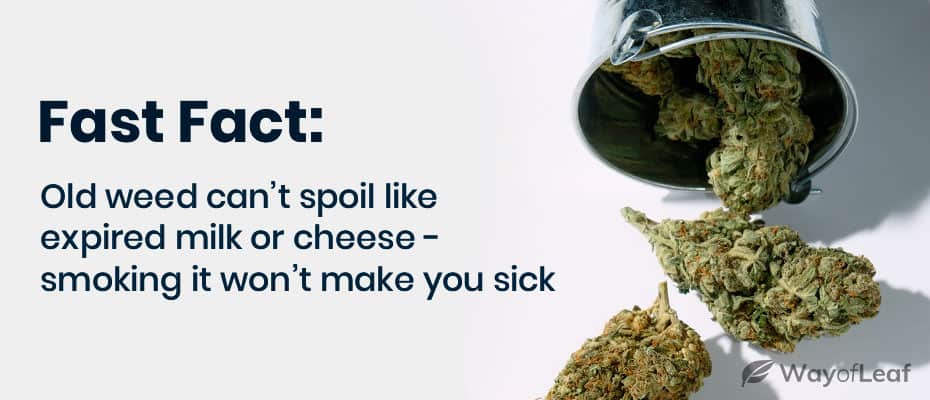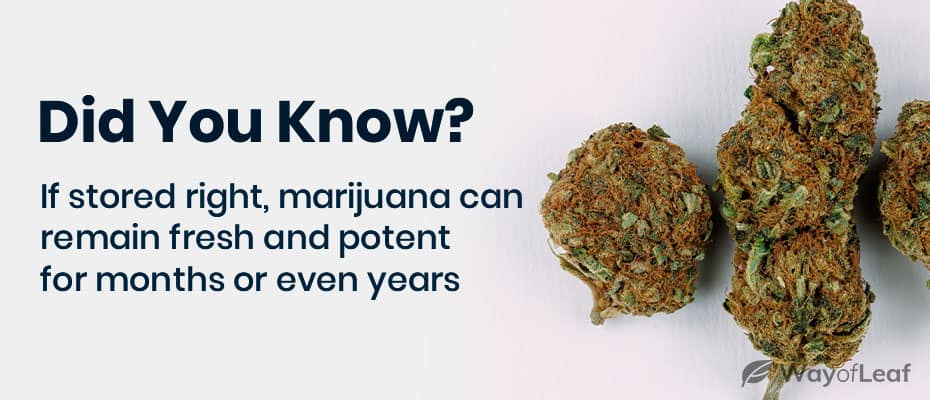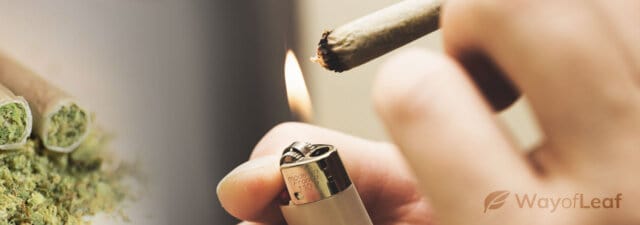Picture the scene; you are rummaging through your house during a spring clean and come across some weed you had completely forgotten about. You’re not sure how long it has been there, but you want to know if it is ‘safe’ to use it or if it has gone bad. The short answer to this query is ‘it depends on your definition of bad.’ The precise longevity of marijuana depends on a variety of factors, but the method of storage is front and center.
What Happens to Old Weed?
First and foremost, marijuana will not go ‘bad’ in the sense that it will cause harm to a user. Weed is different from food in this respect. When we say that food ‘goes off’ or ‘rots,’ we mean it is unsuitable for human consumption. Food goes bad because microorganisms colonize it and the gases released by its decomposition are the cause of the awful smell you get.
Unlike food, cured and dried cannabis isn’t a breeding ground for microorganisms. You still have to worry about them while you’re still growing your crop, of course! As a result, if you have ancient weed that has been stored properly, it is probably ‘okay’ to use, although it won’t be as potent as before.
As for using old cannabis found on the floor, it ‘probably’ won’t cause much harm if it was well cured and dried. The bud will look brown, disheveled, and extremely unattractive! If you live in a legal state, it makes more sense to toss away the old herb and invest in some new bud.
One thing certain to happen to old cannabis is a reduction in potency.
There are over 110 identified cannabinoids in marijuana, with THC and CBD the most abundant, followed by CBN. The cannabinoid composition varies depending on the strain. When your marijuana has been harvested, cut, and dried, its cannabinoid content begins to change over time because cannabinoids react to the presence of oxygen, light, and heat.
As weed grows, it produces cannabigerolic acid (CBGA) which is synthesized into CBCA, CBDA, and THCA. What’s interesting is that the cannabinoids we love, THC and CBD, for example, must be activated to take effect. Raw cannabis contains THCA which doesn’t become THC until you apply heat to ‘decarboxylate’ it.
Once you expose THC or THCA to UV light or the atmosphere for a long enough period, further changes will happen. Eventually, the compounds degrade to CBNA and CBN. To be clear, CBN (cannabinol) isn’t ‘bad’ for you at all. However, it won’t provide you with the psychoactive high you seek, and a high level of it typically makes you feel groggy.

CBN is an effective sedative, so if you want to get some sleep and feel the relaxation in your muscles without a potent psychoactive high, you may enjoy the experience. If your weed is extremely old and wasn’t properly stored, the buds will have dried out, and you’ll probably endure a very harsh smoke. You can alleviate some of the problems by vaping the old weed, but it combusts quicker than new bud, so don’t expect to get much vapor!
In case you were wondering, cannabis concentrates experience the same changes if left exposed to light and air over time. The cannabinoids and terpenes in the substance will fall, so old concentrates won’t taste as good as new ones, and will also have a high CBN content. If you want to slow down the process of degradation, it is necessary to remove UV light and oxygen, the two factors that cause the chemical change.
What About Old Edibles?
Things change when discussing old cannabis edibles. While the THC content gradually degrades in CBN, which isn’t harmful, the other ingredients in edibles, such as eggs and milk, WILL go off.
Admittedly, major issues such as salmonella and E. coli arise due to contamination instead of decay, but eating old edibles means you are gambling on not having an upset stomach or getting sick.
If you are worried about an expiration date found on a purchased edible, it is probably a good idea to bin it. At best, it won’t make you sick but will taste like ass. If you make your edibles, store excess portions in the freezer.
Airtight Storage
One weed lover/scientist decided to find out exactly what happens to cannabis as it ages and sent a five-year-old sample into the Cannalysis testing lab. We already know that THC transforms into CBN when exposed to oxygen. CBN is known for its exceptional healing properties and is also a very effective sleep aid according to users. The sample in question was kept in a glass mason jar, so exposure to air was minimal. As a result, the weed’s THC content remained high, although the percentage of CBN also increased slightly.
In terms of aesthetics, the buds were less resplendent in terms of glimmer and color. When the buds were new, they were sticky, but after five years of airtight storage, they had become crunchier, although the trichomes were still in excellent condition. Rather surprisingly, the terpene content and scent remained strong, although the first whiff of the weed after opening the jar was awful!
The marijuana also had a different taste, with a dry and earthy flavor and a relatively harsh throat hit. Overall, weed that has been stored in an airtight container will still provide you with a decent experience after several years.
Improperly Stored
Depending on where the weed was stored, the bud will become damper or drier with age and will have an extremely high CBN count. If the weed is dry when you find it, you can safely smoke it, although you should prepare for very harsh hits. If the weed is damp, there is a chance it will develop mold, and trying to smoke moldy marijuana IS a health hazard. Incidentally, while the oldest known marijuana stash contained a high level of CBN, the 2,700-year-old sample still contained a reasonable amount of THC; enough to get a novice user high at the very least!
A bigger problem is if your old marijuana has been exposed to damp conditions. Weed can develop mold during the growing cycle, or if it has been stored with an excessive level of moisture in it. Regardless of how it happens, using moldy cannabis is a health hazard. Use a magnifying glass to check any bud you suspect of being moldy. The mold itself resembles a dense cobweb and usually has a gray coloring.
An alternative is to shine a black light on the bud. Any mold on it will have an obvious green hue. Smoking mold means inhaling thousands of toxic spores, which can cause serious respiratory problems. Regardless of its age, dump any moldy marijuana you find.
Identifying Old Weed That May Be Past Its ‘Best Use’ Date
In summation, marijuana stored in an airtight container away from direct heat and also not kept in a damp location can last many years and remain perfectly usable. However, the weed you purchase isn’t always necessarily kept in such pristine conditions, so you have to know when someone is trying to sell you bad marijuana. Alternatively, if you find old weed and don’t know how long it has been hidden, you need to check these pointers to ensure you’re not using stale cannabis that is certain to have a nasty taste.
Appearance
Excessively old and dried out weed will break apart into a fine powder with ease. While it may initially resemble kief, stale marijuana may also contain seeds and stems. You can identify mold fairly easily once you know what to look for. Check out the location of the offending substance’s concentration to determine whether it is mold or trichomes: Mold grows over trichomes and looks like a mass of white powder capable of penetrating every surface of the herb. You can also spot mold when you break apart the nugs.
Smell
Terpenes don’t last long on poorly stored weed. Therefore, if your cannabis offers a pleasant scent, it is almost certainly fit for consumption. Beware marijuana with a mildew-type smell, as this is a sign of possible mold growth. If you get a weird chemical aroma, it probably means that pesticides or other chemicals have been used to treat the weed while it grew.
Texture
Pulling apart the nugs should tell you everything you need to know about the condition of the weed. You can determine whether there is any moisture content or see if it falls apart in your hands. Herb that is well cured and dried will make a ‘snapping’ sound when you handle it, whereas old cannabis makes a cracking sound and also feels extremely dry.
Taste
If your marijuana passes all of the above tests, smoke a small amount to be 100% sure. One thing about ‘bad weed’ is that you will taste the problem almost immediately!
Preparing & Storing Your Marijuana for the Long-Term
The first step towards keeping cannabis in long-term storage is to ensure it is dried and cured properly after harvest. If you don’t grow it yourself, make sure you purchase your herb from a licensed dispensary.
Poorly cured and dried weed is susceptible to mold, and has an unpleasant aroma and taste because the plant’s chlorophyll hasn’t been properly broken down.
Dried and cured weed is also more potent.

Assuming you buy the weed from a dispensary, the curing and drying processes are already done for you. As a result, all you have to worry about is storage. Even basic adherence to long-term storage principles means your weed should last at least a year. To prevent weed from drying out too fast, make sure you avoid the following:
- Storing it in a plastic bag.
- Keeping it in a container that’s far too large.
- Exposing it to excessive light or heat.
As we mentioned earlier, the biggest enemies of marijuana preservation are light and oxygen. If you avoid exposing your herb to these two factors, you reduce the rate of degradation from THC into CBN. There are air-tight containers available online for a few bucks that can do the job. The best option is a container with a brown tint to help block out the light. Plastic Tupperware is clear and doesn’t stop lighting from getting in.
Keep the lids of your containers sealed and store them in a cool and dry place such as the back of a cupboard; check that the cupboard doesn’t have mold! It is best to avoid storing it in a fridge or freezer. Doing so could cause condensation to form and cause the growth of pathogens. Freezing weed may also cause it to become brittle once you defrost it.
Poorly stored cannabis could dry out and become harsh to your lungs in a matter of days.
If you are serious about keeping your marijuana fresh and are intent on purchasing a fairly large supply, consider investing in Humidity Packs. If you purchase one, you can keep your weed in an airtight glass jar in the humidity pack and expect it to remain fresh for at least six months. The pack keeps the humidity between 60% and 65%, but you have to keep the herb stored between 60 and 68 degrees Fahrenheit.
For the ultimate in long-term storage, look no further than vacuum sealing. It is a packaging method popular in the food industry. Vacuum sealing involves removing the air from a package before you seal it.
If it sounds like hard work, you’ll be relieved to discover that there are numerous products on the market that do almost everything for you. When you properly vacuum seal cannabis, you reduce atmospheric oxygen and retain its compounds.
One thing to remember is to avoid using any material containing bisphenol A; a harmful industrial chemical believed to cause issues with various bodily functions. Also, even vacuum-sealed weed should be kept away from the light!
Final Thoughts on “Does Weed Goes Bad?”
As long as marijuana is properly harvested, cured and dried, it can age well for a significantly long time, and smoking it is unlikely to cause any deleterious health effects. That said, it will probably taste awful and your lungs and throat will not thank for you for the extremely harsh smoke. And remember that if your cannabis is stored in a location exposed to excessive moisture, mold will grow and smoking such herb is likely to make you extremely ill.
Heat, light, and moisture are the enemies of long-term marijuana storage, so if you want your weed to taste good months after purchasing it, store it in an airtight container in a cool, dark place. Over time, the potency of your cannabis will dwindle, but even though some of the THC will transform into CBN, you should still derive some medicinal benefits; although the ‘high’ will feel weird and not necessarily pleasant. At least one experiment found that weed stored in an airtight container for five years still tasted good and offered a nice, potent kick.





![Hemp vs. Linen [Which Is Best]](https://wayofleaf.com/wp-content/uploads/2019/03/wol_hemp-vs-linen-640x225.jpg)

![How to Tell the Good Weed from the Bad [5 Techniques]](https://wayofleaf.com/wp-content/uploads/2019/06/wol_1920x450-12-640x225.jpg)
![Is Kief Stronger Than Regular Cannabis? [Answered]](https://wayofleaf.com/wp-content/uploads/2018/11/wol-banner-is-kief-stronger-than-regular-cannabis-640x225.jpg)
![How to Make THC Oil for E-Cigs? [Explained]](https://wayofleaf.com/wp-content/uploads/2019/06/wol_1920x450-6-640x225.jpg)
![How Many Grams Are in an Ounce of Marijuana? [Exact Answer]](https://wayofleaf.com/wp-content/uploads/2019/03/wol-banner-how-many-grams-in-an-ounce-640x225.jpg)

